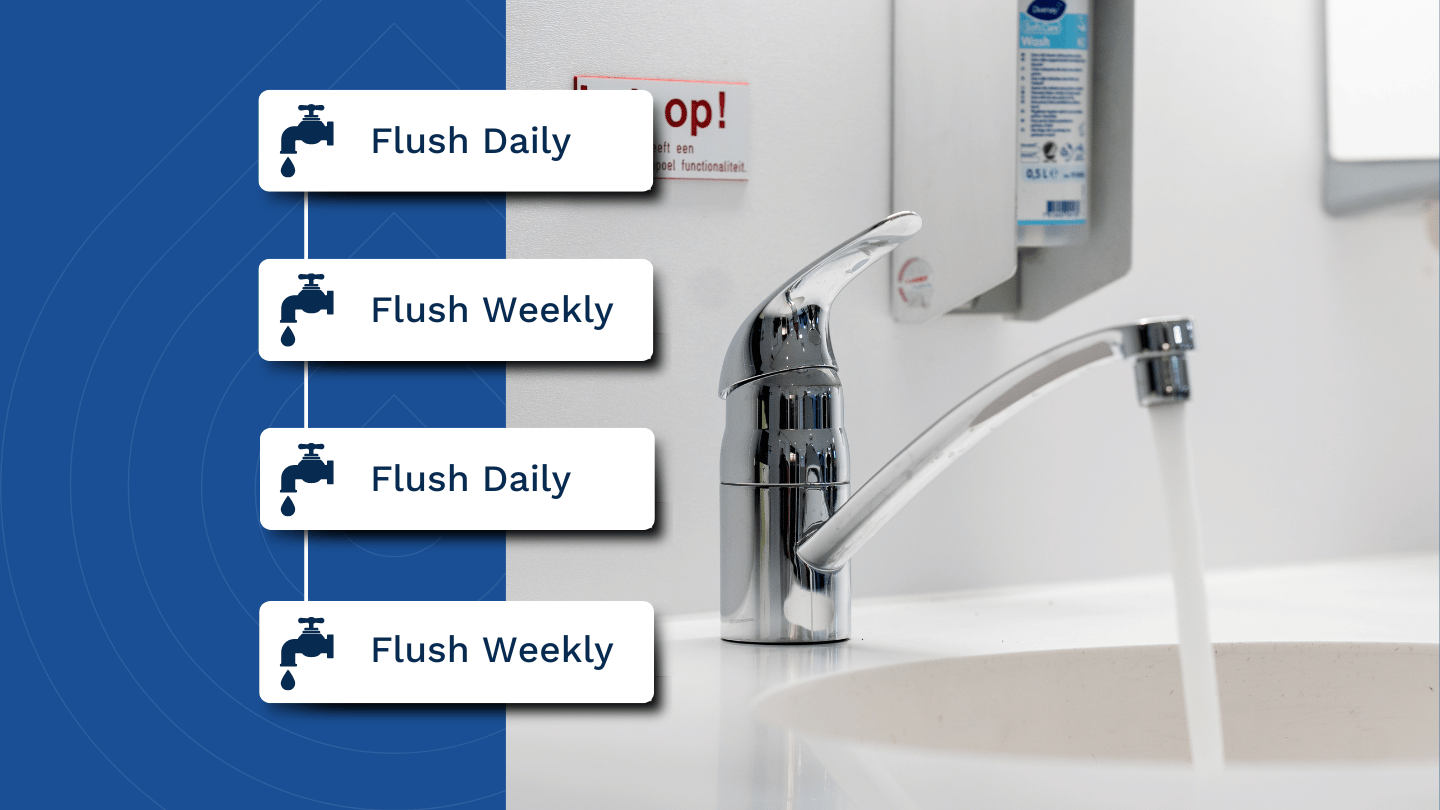Everything You Should Know About Legionella Risk Assessments
Ensuring the safety and quality of your water systems is crucial, and a Legionella Risk Assessment is a key part of this process. In this blog post, we’ll cover everything you need to know about Legionella Risk Assessments, including what they are, why they are necessary, who needs them, and how they can be conducted.
Whether you’re a business owner, landlord, or facility manager, understanding and implementing these assessments is essential for maintaining a safe environment and complying with regulations, such as the COSHH, L8 ACoP and HSG274.
Read on to get all the essential information and ensure your water systems are properly managed and safe from Legionella bacteria.

Table of contents
- What is a Legionella Risk Assessment?
- When and Why is a Legionella Risk Assessment Required?
- Who Needs and is Responsible for a Legionella Risk Assessment?
- How to Get a Legionella Risk Assessment and Who Can Do It?
- What Does a Legionella Risk Assessment Involve and Include?
- When Should a Legionella Risk Assessment be Carried Out and Reviewed?
- How Often Should a Legionella Risk Assessment be Done?
- Resources for Legionella Risk Assessments
What is a Legionnaires Risk Assessment?
A Legionella Risk Assessment is like a health check-up for your water systems. It helps identify if there’s a risk of Legionella bacteria growing in your water. Legionella bacteria can cause serious illnesses, primarily Legionnaires’ disease, which is like a severe lung infection, and Pontiac fever, a milder flu-like illness.
There are different types of Legionella bacteria, but Legionella pneumophila is the most common and dangerous one associated with human disease. This assessment ensures your water is safe to use and won’t make anyone sick by preventing the growth and spread of these harmful bacteria.
When and Why is a Legionella Risk Assessment Required?
A Legionnaires Risk Assessment is required when:
- You have a water system in a building or workplace and need to ensure its safety.
- You own or manage places like hotels, schools, offices, or homes with complex plumbing systems.
- You make changes to your water system.
- It’s been a while since the last check.
It is also mandatory by law to prevent the risks of Legionnaires’ disease. Several laws and regulations enforce this requirement:
- L8 Approved Code of Practice (ACOP): This is the main regulation that provides guidelines on controlling Legionella bacteria in water systems. It states that employers and those in control of premises must identify and assess sources of risk, manage and prevent these risks, keep and maintain correct records, and ensure that the correct measures are in place.
- HSG274: This set of documents offers detailed technical guidance on the control of Legionella bacteria in water systems. HSG274 Part 2, for example, gives specific advice on the control measures needed in hot and cold water systems.
- Health and Safety Executive (HSE): The HSE enforces health and safety law in the UK. Their guidelines emphasize the necessity of regular risk assessments and the implementation of effective control measures to prevent Legionella outbreaks.
- Control of Substances Hazardous to Health (COSHH) Regulations: These regulations require employers to control substances that are hazardous to health, including biological agents like Legionella. Under COSHH, employers must assess risks, implement precautions, and ensure proper maintenance and monitoring of systems.
- Legionella Control Association (LCA): The LCA provides guidelines and standards for service providers involved in the control of Legionella bacteria. Their Code of Conduct ensures that companies meet high standards of compliance and safety in managing Legionella risks.
These regulations collectively ensure that Risk Assessments are not only necessary but are carried out to a high standard to protect public health.

Who Needs and is Responsible for a Legionella Risk Assessment?
Anyone who owns or manages a building with a water system should get a Legionella Risk Assessment. This includes:
- Landlords: Whether you manage residential or commercial properties, ensuring the safety of the water system is crucial to protect tenants from Legionella bacteria.
- Business Owners: If you operate a business that uses water systems (e.g., in offices, hotels, gyms, or factories), it’s your responsibility to ensure these systems are free from Legionella risk.
- Facility Managers: Managing the water systems in large facilities, such as hospitals, schools, and leisure centers, involves regular risk assessments to safeguard public health.
How to Get a Legionella Risk Assessment and Who Can Do It?
To get a Legionella Risk Assessment, you should hire a legionella risk assessment company or a legionella risk assessor. These professionals have the training and experience to perform the assessment correctly. They will:
- Conduct a thorough inspection of your water systems.
- Identify any potential risks for Legionella bacteria growth.
- Test water temperatures and quality.
- Review how water is stored and used within the system.
- Provide a comprehensive legionella risk assessment report with technical recommendations to mitigate any identified risks.
While it’s technically possible to do your own assessment, it’s not recommended unless you have the proper training.
What Does a Legionnaires Risk Assessment Involve and Include?
A Legionella Risk Assessment involves:
- Inspecting your water system.
- Checking for areas where Legionella bacteria might grow.
- Testing water temperatures.
- Reviewing how water is stored and used.
- Creating a report with recommendations to keep the water safe.
In a Legionnaires risk assessment report you want to include:
- Site risk score and review frequency.
- System risk and description.
- Technical recommendations.
- Control & management structure
- Responsible persons
- Inspection of management & control scheme
- Scheme of safe operations
- Assessment of the water mains
- Mains
- Cold water storage
- Hot water storage
- Hot & cold water distribution systems
- Asset register
- Schematics
- Qualification of the company
- Qualification of the risk assessor
When Should a Legionella Risk Assessment be Carried Out and Reviewed?
A Risk Assessment should be carried out:
- Initially: When setting up a new water system or when a new building is occupied.
- Regularly: Typically at least once a year, depending on the complexity and use of the water system.
- After Changes: Whenever there are significant changes to the water system or its usage.
- When Moving In: Upon moving into a new building or taking control of a new facility.
It should be reviewed:
- Annually: Regular reviews are essential to ensure ongoing safety.
- After Modifications: Any changes to the water system or its usage should prompt a review.
- Change in Usage: If the building’s use or occupancy changes significantly, a review is necessary.
How Often Should a Legionella Risk Assessment be Done?
A Legionnaires Risk Assessment should typically be done once a year. However, the frequency can vary depending on the size and complexity of your water system. Follow the guidelines provided in your initial assessment.
Resources for Legionella Risk Assessments
For those looking to understand what a Legionnaires Risk Assessment involves, there are resources like Legionella Risk Assessment Templates, Example Reports, and PDF documents available. These can help you see what the process looks like and what information is included in the assessment.
Is your Legionnaires Risk Assessment still up to date?
Are your water systems safe? Ensuring the safety and quality of your water system is a significant challenge — managing and mitigating risks like Legionella bacteria is even tougher. After putting in all that effort, it’s crucial to see tangible results, namely a safe environment and compliance with health regulations. Legionella risk assessments will tell you how well you’re achieving this goal.
These evaluations are straightforward and actionable, guiding you to where potential issues might lie so you can address them promptly. A water safety strategy is incomplete without regular risk assessments. If you haven’t started conducting these assessments, now’s the time.
Editor’s note: This post was originally published in July 2024.
Interested?
Experience the benefits yourself!



